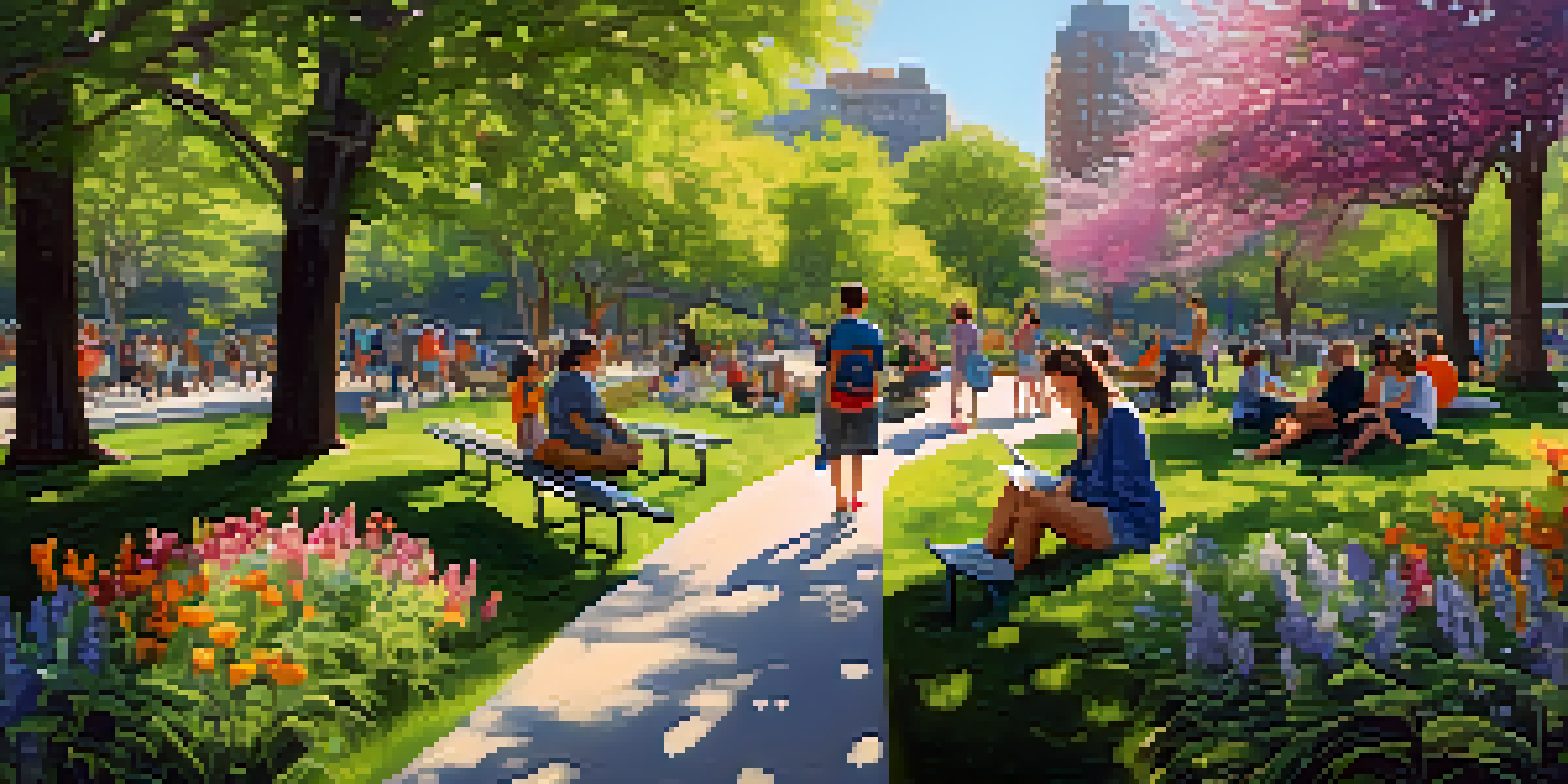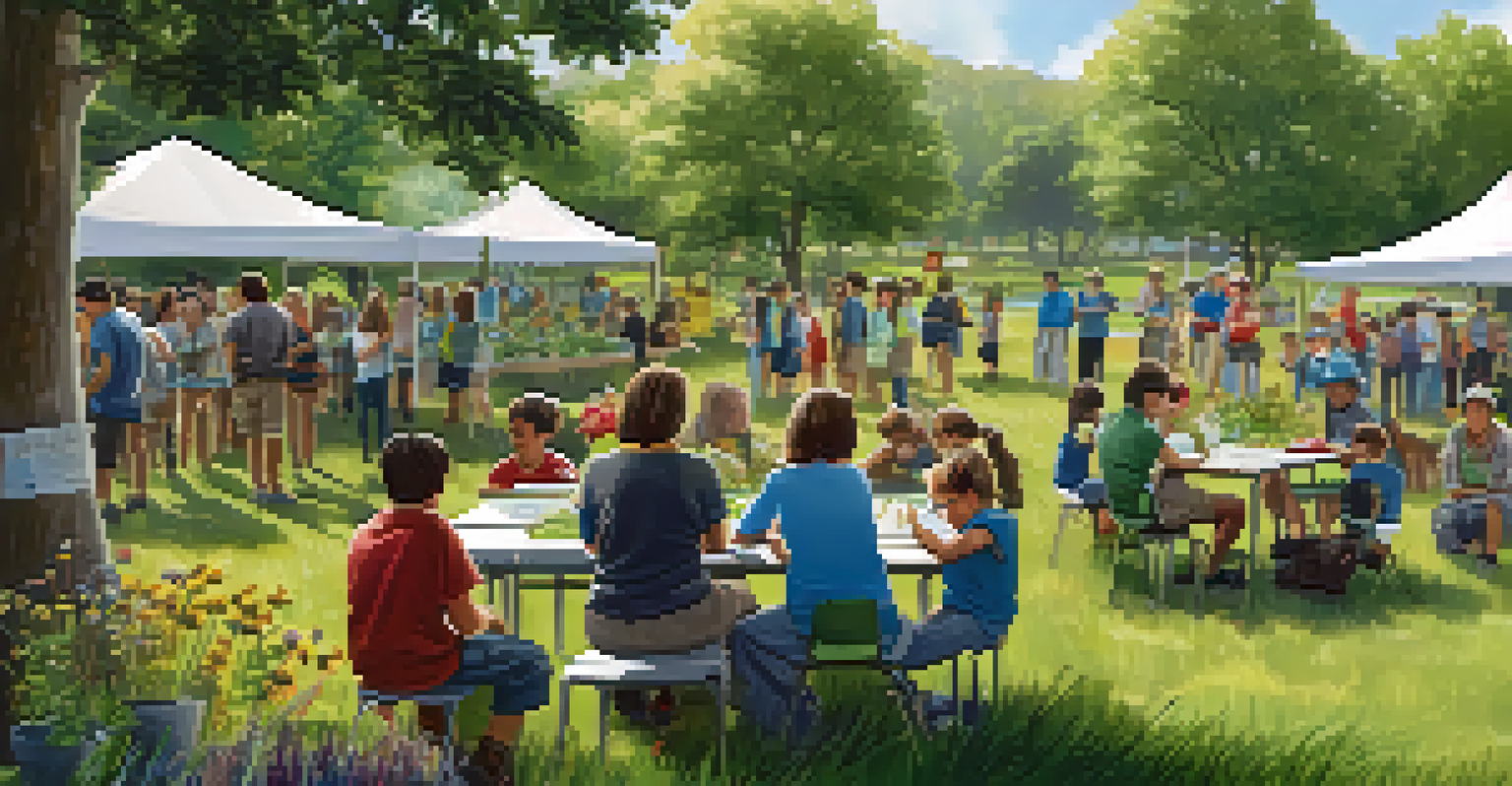The Role of Parks in Supporting New York City Biodiversity

Parks as Vital Green Spaces in Urban Environments
Parks serve as essential green spaces amidst the concrete jungle of New York City. They provide a refuge for wildlife and a place for residents to connect with nature. In a city where skyscrapers dominate the skyline, parks act as lungs, absorbing carbon dioxide and releasing oxygen, thus improving air quality.
Parks are not just a place to relax; they are essential ecosystems that support wildlife and improve urban environments.
These green areas not only enhance the aesthetic value of the urban landscape but also play a crucial role in maintaining ecological balance. By offering habitats for various plant and animal species, parks help sustain biodiversity. This is especially important in urban settings, where natural habitats are often fragmented or destroyed.
Moreover, parks contribute to the overall health of the environment by mitigating urban heat and controlling stormwater runoff. They create microclimates that support diverse plant life and provide shelter for birds, insects, and other wildlife, showcasing the importance of preserving these urban oases.
Encouraging Native Species Through Urban Parks
One of the key roles of parks is to foster native species, which are essential for maintaining local ecosystems. Native plants and animals have evolved to thrive in their specific environments, making them more resilient to local climate conditions and pests. By planting native species in parks, New York City can support the wildlife that relies on them for food and shelter.

For example, the New York City Parks Department has initiated several programs to restore native plant species, which helps attract pollinators like bees and butterflies. This not only benefits the parks' ecosystems but also contributes to the larger urban ecosystem, creating a network of habitats across the city. The presence of these native species enhances the overall biodiversity of the area.
Parks Enhance Urban Biodiversity
Urban parks provide essential habitats for native species, supporting local ecosystems and promoting biodiversity.
In doing so, parks become living laboratories for education and conservation efforts. They provide opportunities for residents to learn about the importance of native species and how they can contribute to biodiversity in their own neighborhoods.
Parks' Role in Wildlife Migration and Habitats
Urban parks also play a crucial role in wildlife migration and habitat connection. As cities expand, natural habitats are often disrupted, making it difficult for animals to find food and shelter. Parks can serve as important corridors that allow wildlife to move between fragmented habitats, ensuring genetic diversity and population stability.
The creation of parks is not only about beautifying the city; it's about preserving biodiversity and providing a refuge for both people and nature.
Birds, for instance, rely heavily on urban parks during migration seasons. Parks like Central Park have been recorded as critical resting stops for migratory birds, providing them with food sources and safe havens. This not only supports the birds but also offers residents a chance to engage with nature and witness the beauty of migratory patterns.
In addition to birds, many small mammals and insects also utilize park spaces as habitats. By maintaining and enhancing these green areas, cities can help sustain the various species that call them home, further enriching the urban biodiversity.
Parks and Their Impact on Pollinator Populations
Pollinators are vital for maintaining healthy ecosystems, and urban parks can significantly impact their populations. Bees, butterflies, and other pollinators thrive in environments with diverse plant life, making parks essential for their survival. By planting a variety of flowering plants, parks can create habitats that support these critical species.
For example, the creation of pollinator gardens within parks has become a popular initiative in New York City. These gardens are designed to attract and support pollinators by providing them with a rich source of nectar and pollen. As a result, they not only enhance the beauty of the parks but also contribute to the overall health of the surrounding ecosystem.
Parks Mitigate Climate Change Effects
By acting as carbon sinks and absorbing excess rainwater, urban parks play a vital role in combating the impacts of climate change.
Moreover, engaging the community through educational programs about the importance of pollinators can foster a deeper appreciation for nature. This awareness can lead to increased support for park initiatives, ensuring that these vital green spaces continue to thrive and support biodiversity.
Parks as Educational Platforms for Biodiversity Awareness
Parks are not just places for leisure; they also serve as powerful educational platforms for promoting biodiversity awareness. Many parks host programs and workshops that teach visitors about the local flora and fauna. This hands-on approach helps individuals understand the importance of biodiversity and their role in preserving it.
Schools often organize field trips to parks, allowing students to explore nature firsthand. These experiences can instill a sense of responsibility towards the environment from a young age. By fostering a connection with nature, parks encourage future generations to become stewards of the earth.
Additionally, community events like nature walks and volunteer days for habitat restoration can deepen the public's engagement with biodiversity. As people learn more about the ecosystems in their backyards, they are more likely to support conservation efforts and advocate for the protection of these vital green spaces.
The Role of Parks in Climate Change Mitigation
Climate change poses significant threats to urban biodiversity, but parks can help mitigate some of these effects. By acting as carbon sinks, parks absorb CO2, thereby reducing greenhouse gases in the atmosphere. This function is particularly important in densely populated cities like New York, where air quality can suffer due to pollution.
Moreover, parks help combat urban heat by providing shaded areas and cooling green spaces. This can alleviate the heat island effect often experienced in cities, where temperatures can be several degrees higher than in surrounding areas. By maintaining cooler temperatures, parks create more hospitable environments for various species.
Community Engagement is Crucial
Active participation from local residents in park stewardship fosters a sense of ownership and enhances biodiversity conservation efforts.
Additionally, parks can improve resilience to climate-related events, such as heavy rainfall or flooding. Their natural landscapes can absorb excess water, reducing runoff and preventing erosion. This multifunctional role illustrates how parks are not only essential for recreation and relaxation but also crucial for environmental sustainability.
Community Engagement and Stewardship in Parks
Community engagement is vital for the success of urban parks and their role in biodiversity. Local residents often take pride in their parks and play an active role in their maintenance and improvement. This stewardship fosters a sense of ownership and responsibility towards the green spaces that contribute to their well-being.
Volunteer programs can mobilize community members to participate in activities such as tree planting, invasive species removal, and habitat restoration. These initiatives not only enhance the parks but also strengthen community bonds and increase awareness about the importance of biodiversity.

Furthermore, engaging the community in decision-making processes regarding park management can lead to more tailored and effective conservation strategies. When residents are involved, they are more likely to advocate for the preservation and enhancement of their local parks, ensuring that these vital ecosystems continue to thrive.
Future Challenges and Opportunities for NYC Parks
While New York City's parks play a crucial role in supporting biodiversity, they face numerous challenges. Urban development, pollution, and climate change threaten the delicate ecosystems within these green spaces. As the city continues to grow, finding a balance between development and conservation becomes increasingly important.
However, these challenges also present unique opportunities for innovation and collaboration. For instance, integrating green infrastructure such as green roofs and rain gardens can enhance biodiversity while addressing urban issues like stormwater management. By embracing sustainable practices, NYC can create a model for other cities to follow.
Ultimately, the future of New York City's parks depends on collective action from the community, policymakers, and environmental organizations. By prioritizing biodiversity in park planning and management, the city can ensure that its green spaces continue to thrive, providing essential benefits for both residents and wildlife.